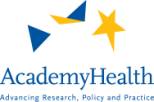| NHII Home | Coordinating Activities | Public Health Related Activities | Standards Organizations | Health Care Organizations | State and Local Activities | MEETINGS | SITE INDEX |
Public Health-Related Activities
 |
| AcademyHealth is the professional home for health services researchers, policy analysts, and practitioners, and a leading, non-partisan resource for the best in health research and policy. The organization promotes the use of objective research and analysis to inform health policy and practice. With a diverse membership that includes more than 3,700 individuals and 125 affiliate organizations, AcademyHealth fosters networking, professional growth, and development for those working to improve health and health care. To learn more about AcademyHealth, please visit www.academyhealth.org. |
| URL: www.academyhealth.org/ |
 |
| All Kids Count (AKC) is a Robert Wood Johnson Foundation-funded project that started in 1992 with the development and implementation of immunization registries. The current phase is one of communication and integration- to foster integration/linkage of child health information systems, specifically including immunization registries and other systems that have both clinical and PH importance--Vital records:Newborn Metabolic Screening; early Hearing Detection and Intervention; lead poisoning; birth defects; Early and Periodic Screening, Detection, and Treatment (EPSDT)/Medicaid; Women, Infants, and Children supplement food program(WIC), etc. One of their major activities is AKC Connections, a collaboration of state and local health departments moving toward integration of health information systems such as immunization registries, newborn metabolic and hearing screening, lead screening, WIC, and EPSDT. |
| URL: www.allkidscount.org |
| Contact: info@allkidscount.org |
 |
| The Health Alert Network (HAN) is a project being developed at the Centers for Disease Control and Prevention (CDC) as part of their Public Health Emergency Preparedness & Response Program. The project is intended to: 1. Ensure communications capacity at all local and state health departments (full Internet connectivity, training) 2. Ensure capacity to receive distance learning offerings from CDC, et al. 3. Ensure capacity to broadcast and receive health alerts at every level |
| URL: www.phppo.cdc.gov/han/Index.asp |
The National Immunization Program (NIP) |
| The National Immunization Program (NIP) is committed to promoting the development and maintenance of state- and community-based computerized registries which capture immunization information on all children. Working with the National Vaccine Advisory Committee (NVAC) , NIP has identified minimal core immunization data elements that enable consistent data collection by immunization registry systems. |
| Contact:siisclear@cdc.gov |
| URL: www.cdc.gov/nip/registry/ |
 |
| The National Electronic Disease Surveillance System (NEDSS) is an initiative that promotes the use of data and information system standards to advance the development of efficient, integrated, and interoperable surveillance systems at federal, state and local levels. This broad initiative is designed to facilitate the electronic transfer of appropriate information from clinical information systems in the health care industry to public health departments reduce provider burden in the provision of information enhance both the timeliness and quality of information provided |
| URL:www.cdc.gov/nedss/ |
 |
| The Public Health Data Standards Consortium (PHDSC) is a voluntary "confederation" of public and private sector organizations with a common interest in developing, promoting, and implementing data standards for public health and health services research through collaboration of State, Federal, and private sector organizations and ensuring that these efforts are appropriately integrated with broader health data standards development efforts. |
| URL:http://www.phdatastandards.info |
 |
| The Public Health Informatics Institute is a program of the Robert Wood Johnson Foundation whose goal is to foster collaboration among public health agencies in the conception, design, acquisition, and deployment of software tools in order to eliminate redundant efforts, speed up development processes, and reduce costs. Current initiatives include: a)Defining Common Requirements-jointly sponsored with APHL, a group of 16 state and local public health laboratories have joined together to address the urgent need to update or acquire new public health laboratory information management systems to enhance bioterrorism preparedness. b)Developing The Exchange-a web-enabled tool to assist public health agencies in making effective IT investment decisions by rating vendor products and their capabilities. |
| Partners: ASTHO, NACCHO, APHL, NAPHSIS, CSTE, APHCIO |
| Contact: David A. Ross, ScD, Director |
| URL:www.phii.org |
 |
| The Public Health Information Network (PHIN) is a framework for crosscutting and unifying data streams for the early detection of public health issues and emergencies. . PHIN is composed of five key components: detection and monitoring, data analysis, knowledge management, alerting and response. Through defined data and vocabulary standards and strong collaborative relationships, the Public Health Information Network will enable consistent exchange of response, health, and disease tracking data between public health partners. |
| Partners: APHL, ASTHO, CSTE, NACCHO, NAHDO, NAPHSIS, HISSB |
| URL:www.cdc.gov/phin/ |
 |
| The Real-time Outbreak and Disease Surveillance System (RODS) is prototype developed at the University of Pittsburgh where real-time clinical data from emergency departments within a geographic region can be integrated to provide an instantaneous picture of symptom patterns and early detection of epidemic events. |
| Contact: |
| URL:www.health.pitt.edu/rods |
